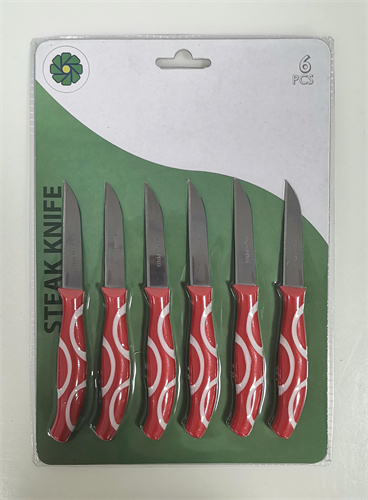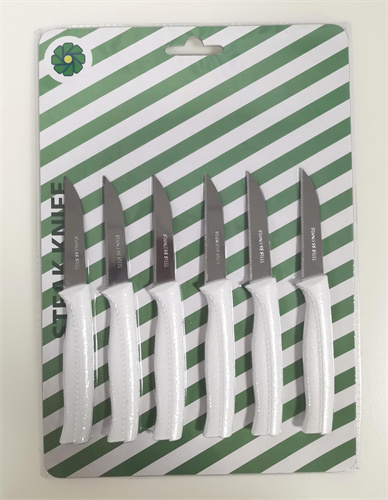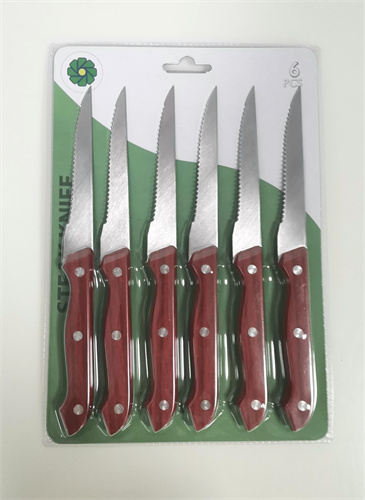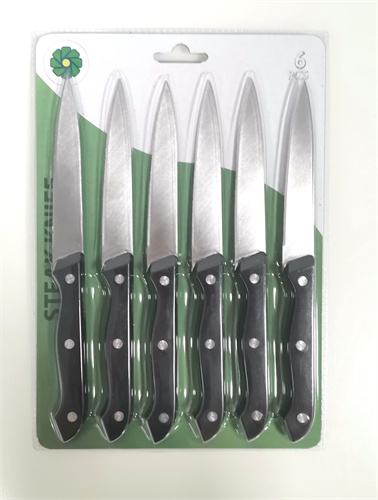

Views: 700 Author: sales@insightknife.com.cn Publish Time: 2025-01-06 Origin: Site








Content Menu
>> The Importance of a Good Steak Knife
>> Characteristics of Serrated Knives
>> Advantages of Serrated Knives
>> Disadvantages of Serrated Knives
>> Characteristics of Smooth Knives
>> Advantages of Smooth Knives
>> Disadvantages of Smooth Knives
● Choosing the Right Steak Knife
● Frequently Asked Questions regarding Steak Knives
>> 1. What is the main difference between serrated and smooth steak knives?
>> 2. Which type of steak knife is better for tough cuts of meat?
>> 3. Are serrated knives harder to sharpen than smooth knives?
>> 4. Can smooth steak knives be used for other kitchen tasks?
>> 5. How do I choose the right steak knife for my needs?
When it comes to enjoying a perfectly cooked steak, the type of knife you use can significantly impact your dining experience. The debate over whether steak knives should be serrated or smooth has been ongoing among culinary enthusiasts and home cooks alike. This article will explore the characteristics, advantages, and disadvantages of both serrated and smooth steak knives, helping you make an informed decision for your kitchen.
Steak knives are specialized utensils designed for cutting steak and other meats. They typically feature a sharp blade and a comfortable handle, allowing for easy slicing. The design of steak knives can vary, but the primary distinction lies in the edge of the blade—serrated or smooth. The choice of knife can influence not only the ease of cutting but also the overall enjoyment of the meal. A well-designed steak knife can enhance the dining experience by providing a sense of elegance and sophistication to the table setting.
A good steak knife enhances the dining experience by making it easier to cut through meat without tearing or shredding. The right knife can also contribute to the presentation of the dish, as clean cuts can make a meal look more appealing. Beyond aesthetics, a quality steak knife can also affect the texture and flavor perception of the meat. When a knife glides smoothly through the steak, it preserves the juices and tenderness, allowing for a more enjoyable eating experience. Therefore, investing in a good steak knife is not just about functionality; it’s about elevating the entire dining occasion.


Serrated steak knives have a jagged edge, resembling small teeth along the blade. This design allows the knife to grip and cut through tougher surfaces more effectively. The serrations create a sawing motion, which can be beneficial when cutting through fibrous or well-cooked meats. The unique design of serrated knives makes them particularly popular in casual dining settings, where ease of use is paramount. Many people find that serrated knives require less technique and skill, making them accessible for all diners, regardless of their culinary expertise.
Ease of Cutting: The serrated edge can make it easier to slice through tougher cuts of meat, such as flank steak or ribeye. The teeth grip the meat, allowing for a smoother cutting motion. This is especially advantageous when serving guests who may not be as comfortable with traditional knives, as it reduces the effort required to enjoy their meal.
Less Pressure Required: Because of the design, serrated knives often require less downward pressure to cut through meat, which can be particularly helpful for those with limited hand strength. This feature makes serrated knives a great choice for individuals who may struggle with grip strength or dexterity, ensuring that everyone can enjoy their meal without frustration.
Durability: Serrated knives tend to stay sharper longer than smooth knives because the points of the serrations do not dull as quickly. This can reduce the frequency of sharpening needed. The longevity of serrated knives makes them a practical choice for busy households or restaurants, where knives are used frequently and need to maintain their performance over time.
Difficult to Sharpen: While serrated knives can maintain their sharpness longer, when they do need sharpening, it can be more challenging. Specialized tools are often required to sharpen the serrated edges effectively. This can be a drawback for home cooks who prefer to maintain their knives themselves, as it may require additional investment in tools or professional sharpening services.
Less Versatile: Serrated knives are primarily designed for cutting meat. They may not perform as well for other kitchen tasks, such as slicing bread or vegetables, compared to smooth knives. This limitation can be a consideration for those who prefer multifunctional kitchen tools, as a serrated knife may not be the best choice for a well-rounded cutlery set.
Tearing Meat: In some cases, the serrated edge can tear the meat rather than providing a clean cut, which may affect the overall presentation of the dish. This can be particularly noticeable with more delicate cuts of meat, where a clean slice is essential for both aesthetics and texture.
Smooth steak knives feature a straight, sharp edge that allows for clean, precise cuts. These knives are often preferred for tender cuts of meat, where a clean slice is desired. The design of smooth knives often emphasizes balance and weight, allowing for a comfortable grip and controlled cutting motion. Many chefs and culinary enthusiasts appreciate the craftsmanship that goes into creating high-quality smooth knives, often viewing them as essential tools in their kitchen arsenal.
Clean Cuts: Smooth knives provide a cleaner cut, which can enhance the presentation of the meat. This is particularly important for fine dining experiences, where the visual appeal of the dish can significantly impact the overall impression of the meal. A clean cut can also help retain the juices within the meat, enhancing flavor and tenderness.
Easier to Sharpen: Sharpening a smooth knife is generally easier and can be done with standard sharpening tools. This makes maintenance more straightforward for home cooks. Regular sharpening can keep the knife performing at its best, ensuring that it remains a reliable tool in the kitchen.
Versatility: Smooth knives can be used for a variety of tasks beyond cutting steak, including slicing fruits, vegetables, and even bread. This versatility makes them a valuable addition to any kitchen, as they can serve multiple purposes without the need for additional specialized knives.
More Pressure Required: Cutting through tougher meats may require more force with a smooth knife, which can be challenging for some users. This can lead to frustration, especially when trying to enjoy a meal without excessive effort.
Dulling Faster: Smooth knives may dull more quickly than serrated knives, necessitating more frequent sharpening to maintain their effectiveness. This can be a consideration for those who prefer low-maintenance kitchen tools, as it may require a commitment to regular upkeep.
Less Effective on Tough Cuts: For particularly tough or fibrous meats, a smooth knife may struggle to cut through without tearing. This can be a significant drawback when preparing certain dishes, as it may affect the overall quality of the meal.
Ultimately, the choice between serrated and smooth steak knives often comes down to personal preference. Some people prefer the ease of use that comes with serrated knives, while others appreciate the clean cuts provided by smooth knives. It’s essential to consider your own dining habits and preferences when selecting a knife, as the right choice can enhance your overall enjoyment of meals.


When selecting a steak knife, consider the types of meat you typically prepare. If you often cook tougher cuts, a serrated knife may be more beneficial. Conversely, if you primarily serve tender cuts, a smooth knife may be the better option. Understanding the characteristics of the meats you enjoy can guide your decision, ensuring that you choose a knife that complements your cooking style.
Regardless of the type of knife you choose, the quality of the knife is crucial. A well-made knife, whether serrated or smooth, will perform better and last longer. Look for knives made from high-quality materials, such as stainless steel, and consider the handle's comfort and grip. Investing in a quality knife can pay off in the long run, as it will enhance your cooking experience and provide reliable performance for years to come.
The debate over whether steak knives should be serrated or smooth is unlikely to be resolved definitively, as both types have their merits and drawbacks. Understanding the characteristics and uses of each can help you make an informed decision that suits your cooking style and preferences. Whether you opt for the ease of a serrated knife or the precision of a smooth knife, having the right tools in your kitchen will enhance your culinary experiences and elevate your dining enjoyment. Ultimately, the best steak knife is one that feels comfortable in your hand and meets your specific needs, allowing you to savor every bite of your delicious steak.
The main difference lies in the blade edge. Serrated knives have a jagged edge that helps grip and cut through tougher meats, while smooth knives have a straight edge that provides clean, precise cuts, making them ideal for tender meats.
Serrated steak knives are generally better for tough cuts of meat, such as flank steak or ribeye, because their jagged edges can grip and saw through the fibers more effectively.
Yes, serrated knives can be more challenging to sharpen because they require specialized tools to maintain the serrated edge. In contrast, smooth knives can be sharpened easily with standard sharpening tools.
Yes, smooth steak knives are versatile and can be used for various tasks beyond cutting steak, including slicing fruits, vegetables, and bread, making them a valuable addition to any kitchen.
To choose the right steak knife, consider the types of meat you typically prepare, your personal preference for ease of use versus precision, and the quality of the knife. A well-made knife that feels comfortable in your hand will enhance your dining experience.